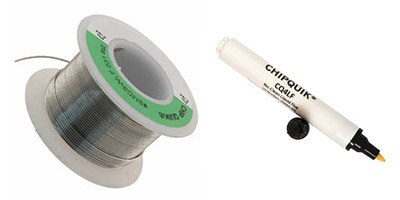Solder and Flux
Choosing solder can be an oddly difficult task. It’s slightly shocking to see how many choices are available the first time you need to purchase it. The point of this blog is to bring better understanding about leaded and lead-free solder, the different types of flux, and solder diameter selections.
Diameter: Let’s start with the diameter. This is largely dependent on what is being soldered, the size of the pads, and the size of the component leads. A good standard for general hobby electronics would be between 0.020"- 0.035". Anything smaller could cause frustration as it would need a lot more to properly solder the joint, thus forcing the user to feed it constantly. Anything larger could simply be too large to solder joints easily. Again, this is dependent on what the user is soldering, but it’s a good starting point.
Leaded vs. Lead-Free: The great debate. Leaded was the industry standard until recently (mid 2000s) as there has been a huge push for everything to comply to RoHS standards (Restriction of Hazardous Substances Directive). Certain regions do not allow leaded solder in commercial electronics.
Leaded solder has a lower melting point than lead-free, making it easier to use. It is also cheaper than lead-free solder, another desirable feature. However, unless you have a fume extractor or adequate ventilation, it’s not recommended. The dangers of lead buildup in our systems has become more of a concern as researchers are learning more about the health issues it can cause. One should also note that if leaded solder is chosen, the user needs to wash their hands after handling it. Residue left on skin can be ingested otherwise. As long as proper precautions are taken, it’s still an exemplary and acceptable choice.

Lead-free solder, while better from a health-conscious point of view, is more expensive and has a higher melting point. It can be difficult to work with. Either type is a fine choice, so it comes down to personal preference on this one.
Flux: Let’s start with what it is. It is an agent created for the purpose of cleaning mildly dirty or oxidized surfaces while soldering. Some solder has a flux core, however it can be purchased separately also. Flux that is not included in the solder can be purchased in a liquid form, so no heat is needed to apply it. Solder core flux has a lower melting point than the solder itself, allowing it to flow over the surface and clean before the solder flows. This helps to create a sturdy joint. If there is any oxidation, grease, oils, etc., on the surface being worked on, the solder will not adhere properly. If the surfaces have been pre-cleaned then flux is not necessary.
There are a few different compositions of flux to choose from: rosin, water-based, and no-clean. Now, as stated earlier, the flux flows over and cleans the surface. It also leaves residue on the surface that isn’t always desirable. Rosin leaves a very sticky residue that requires a chemical solvent (such as rubbing alcohol) to remove it in most cases. Water-based leaves a thin film behind that is easily removed with a small amount of water. No-clean is supposed to burn off during the soldering process leaving little to no residue, but what is left on is very difficult to remove. Now, why clean any of them off? They have been shown to cause corrosion under specific conditions over time, damaging the circuit. Some companies clean them for cosmetic reasons during inspection.
Rosin flux has a few different levels available. Rosin Mildly Activated only utilizes a small amount of the additive that enhances cleaning, leaving less residue behind than Rosin Activated, which simply has more of the additive.
Solder Forms: Now that we’ve gone over solder wire and flux, it’s good to note the other forms that solder can come in. There are solder balls, bars, and paste that are all used to adhere surface mount components to a circuit board. Solder balls are held in place by a tacky flux, then put through the reflow process. Solder bars are melted down and used in reflow soldering. Solder paste is tacky when first placed down, then after it is heated, it forms a strong metallic bond.
Solder Composition: Solder composition can be another overwhelming factor. The most common leaded compositions are: SN60/PB40 (60% tin and 40% lead) and SN63/PB37. The 63/37 (63% tin and 37% lead) composition will melt and solidify more quickly than the 60/40 because of the higher tin content. The most common lead-free composition is SN96.5/AG3.0/CU0.5 (96.5% tin, 3% Silver, and 0.5% Copper). There are plenty of other compositions; however, unless there’s a very specific need, the ones above will be just fine for any basic soldering job.
This blog has touched on the basics of what you need to know about solder. For a tutorial on how to solder, head over to our Soldering Basics video. Otherwise read through the Another Teaching Moment: Soldering article on Maker.io for step-by step-instructions of the process.

Have questions or comments? Continue the conversation on TechForum, Digi-Key's online community and technical resource.
Visit TechForum







 中国
中国